by Jason Bodner
September 12, 2023
September is historically a rough time for many reasons. I write this just ahead of 9/11, perhaps one of the roughest times in American history. The 2001 tragedy claimed the lives of nearly 3,000 people – 400 of whom were firefighters and police officers. Naturally we always think of these victims first, but it could have been orders of magnitude worse. On any given normal business day, as many as 50,000 people worked in the twin towers. I know, because I worked there in the summer of 2001. An additional 40,000 people pass through each day. Any loss of life is tragic, but thank goodness it didn’t turn out far worse.
Remembering those tragically injured and killed that day 22 years ago – hundreds of them my associates at Cantor Fitzgerald, where I trained that summer – helps keep any stock market volatility in perspective.
Daily market swings can be uncomfortable, anxiety-producing, and unpleasant, but any market disturbance is insignificant in the grand scheme of things. I believe this September, barring anything as unforeseen as 9/11, will go down in stock market history as just an average September, which according to history dating back to 1990, offers us an expected drop of just -0.8% on the S&P 500 index:
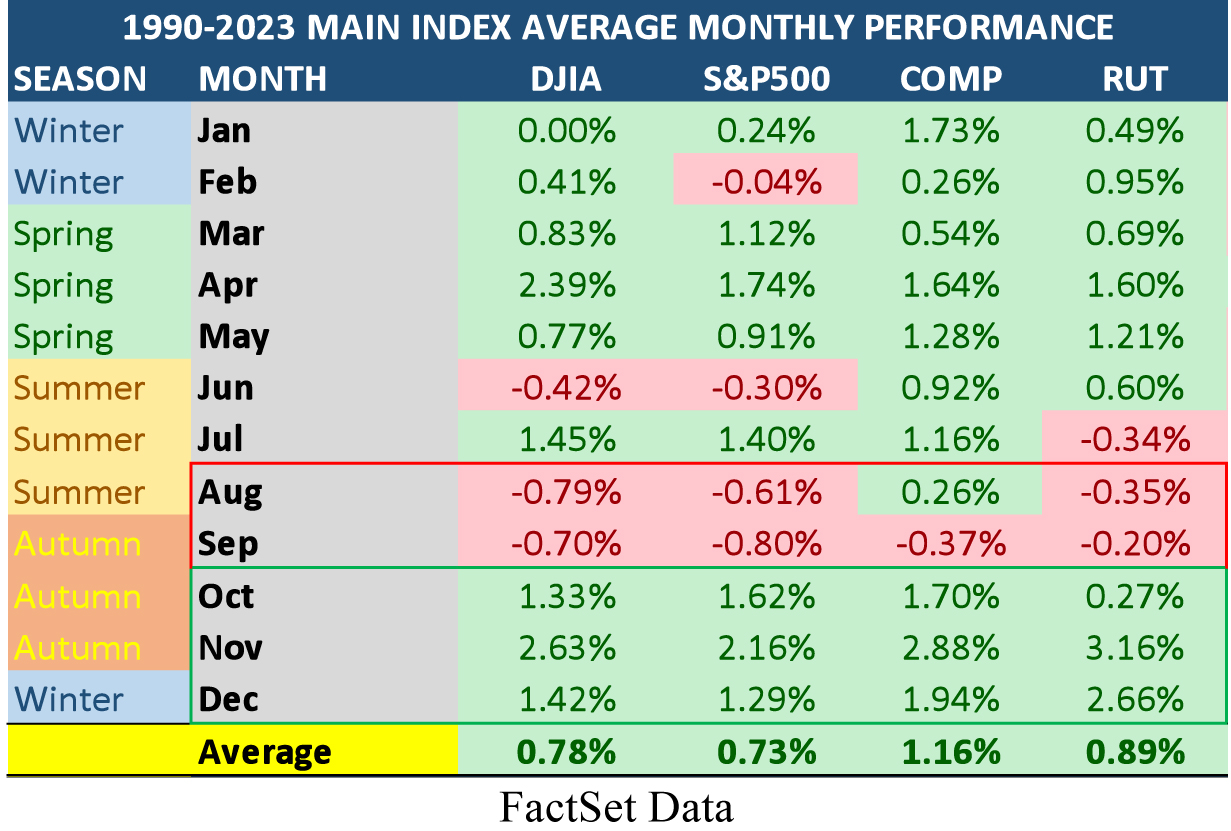
Graphs are for illustrative and discussion purposes only. Please read important disclosures at the end of this commentary.
But there are some interesting follow-ups to these averages:
1) Septembers may be negative on average, but since 1990 we have seen an even split of 16 positive, and 16 negative, Septembers. A 50/50 shot is hardly a measure of consistency. This means it’s entirely possible we will end up with a positive September based on historic data that suggests it’s a coin flip.
2) October through December, by contrast, is much more reliable. It turns out that we have a 75% chance that November and December will deliver a positive performance:
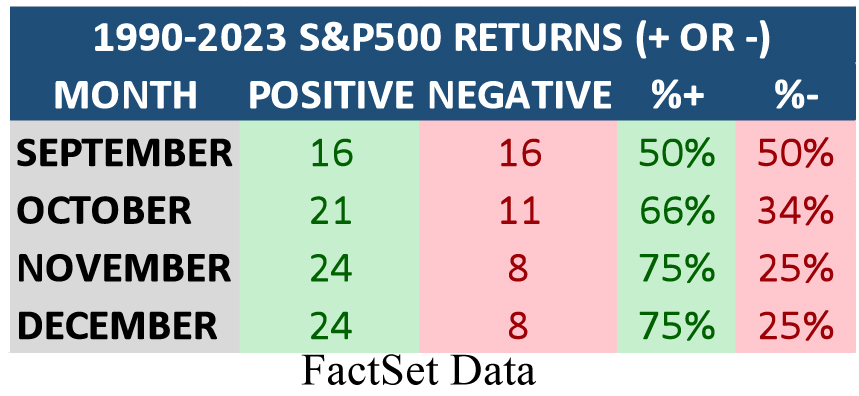
Graphs are for illustrative and discussion purposes only. Please read important disclosures at the end of this commentary.
If you read me regularly, I’m not telling you anything new. Being a data scientist can mean that I can be incredibly boring and repetitive at times. I guess I’m also not telling you anything new there, either. It can be boring or even annoying to read the same thing over and over. But the data is the data. That’s why I love it – there’s no room for emotional attachments. I just analyze and create a framework for forecast.
With that prologue, let’s look at what last week’s data showed us. While the close of August saw a meaningful uptick in both unusual buying and market prices, the first week of September showed us a renewed dose of red. Markets slumped and unusually large signals spiked. This sudden selling further weighs on the Big Money Index (BMI). As I explained last week, the BMI is a 25-day moving average of unusual buys and sells, netted out. July was full of green (buying), but as those green days roll off the data set for the BMI calculation, remaining and new sells continue to pressure the BMI lower:
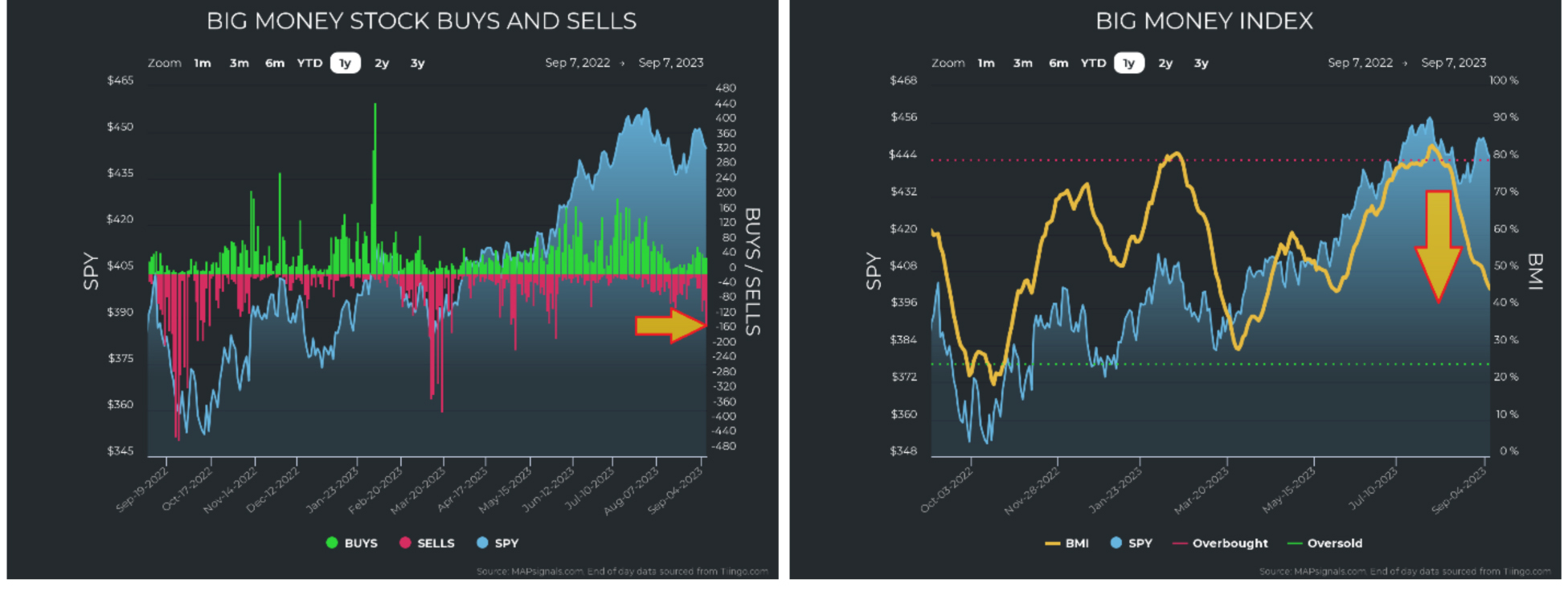
Graphs are for illustrative and discussion purposes only. Please read important disclosures at the end of this commentary.
It’s not entirely all bad news. The price action we saw last week was congruent with an ongoing rotation. Below we see the individual sectors in terms of unusual buying and selling.
What stands out to me is where the buying and selling was taking place. In short, money flowed into energy and technology, and money flowed out of discretionary, staples, and industrials.
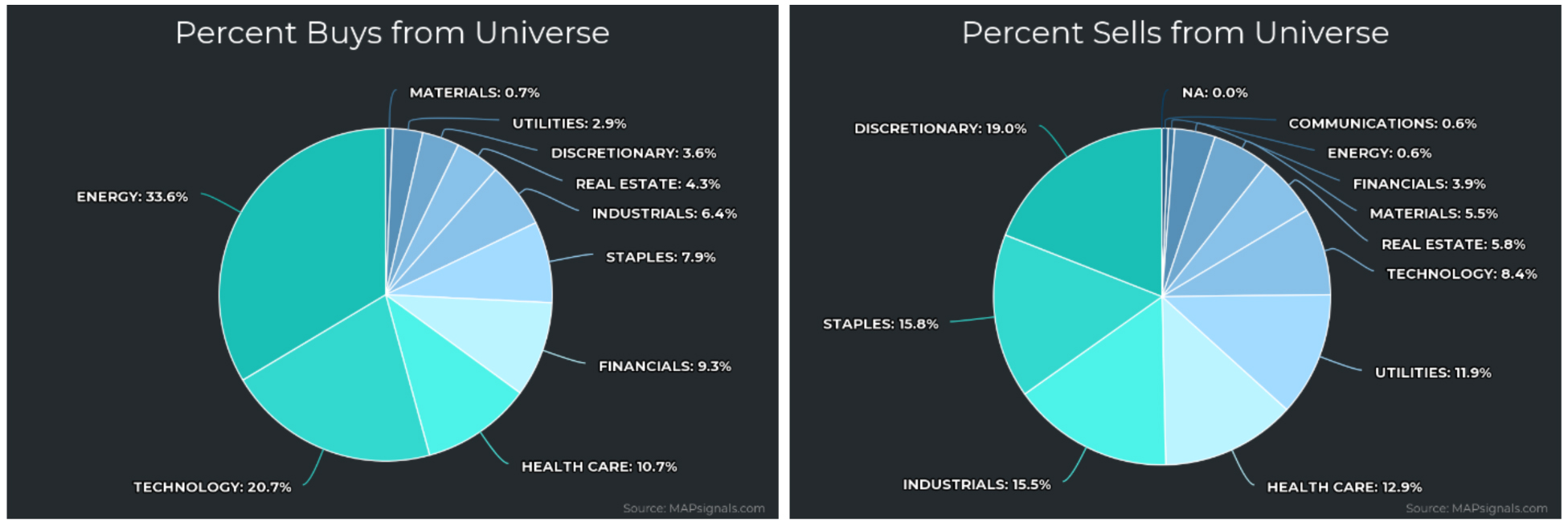
Graphs are for illustrative and discussion purposes only. Please read important disclosures at the end of this commentary.
We can see that in the charts below, too. Notice that tech saw week-long buying, but then a sudden selling spike late in the week. Buying was in larger chip-makers and software firms while selling was in some AI stocks and smaller names. Some iPhone component suppliers also got hit with news about China banning phone sales to, or use by, government employees. We also see the push into energy stocks. As crude oil grinds higher, money flowed into oil and gas exploration and production companies. Discretionary stocks saw outflows broadly from hotels, big brand electronics retail, casinos, rental cars and more:

Graphs are for illustrative and discussion purposes only. Please read important disclosures at the end of this commentary.
When we dig further, we can see that staples were also dumped. Everything from discount retail to old standards like Coke (KO) and Hormel Foods (HRL) was sold in the sector.
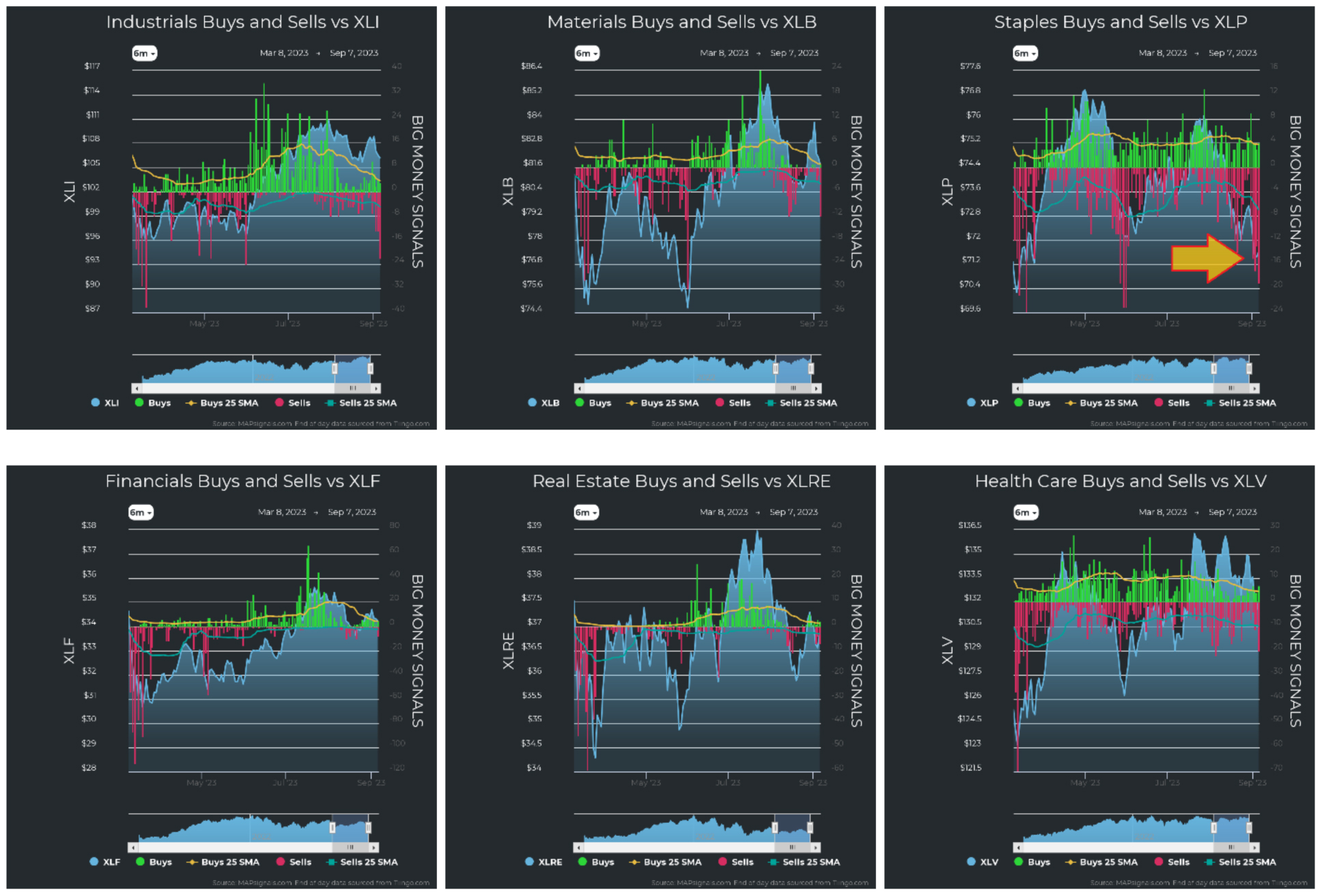
Graphs are for illustrative and discussion purposes only. Please read important disclosures at the end of this commentary.
Lastly, we see an exodus out of utilities stocks:
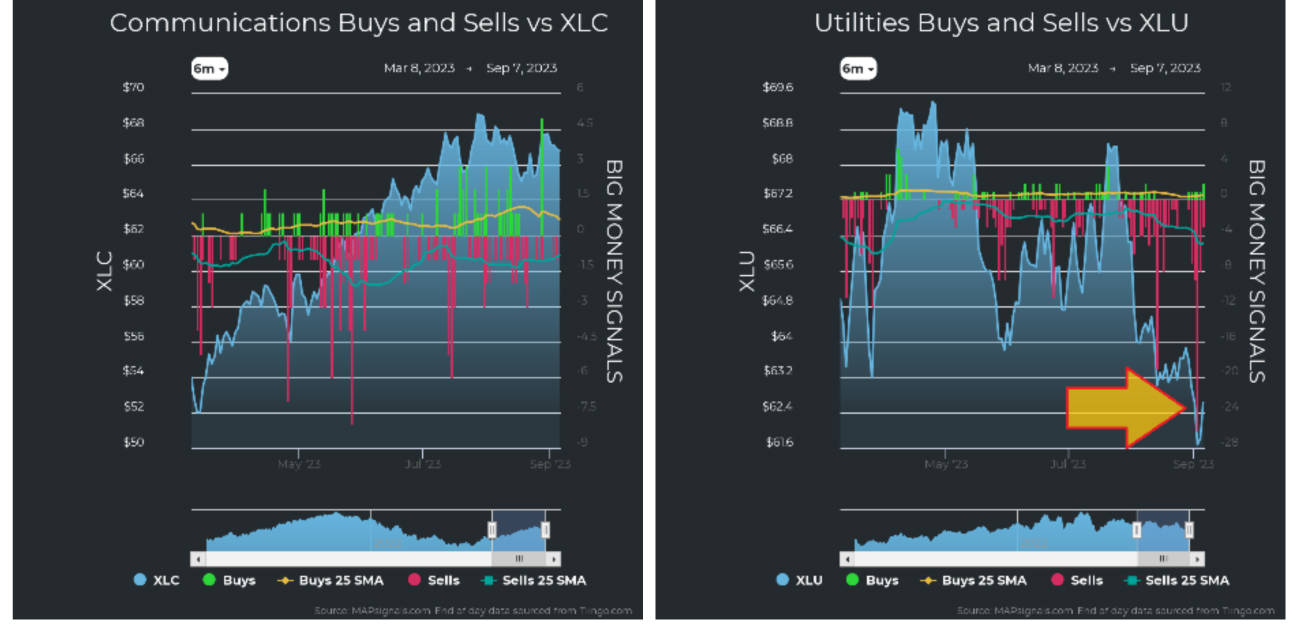
Graphs are for illustrative and discussion purposes only. Please read important disclosures at the end of this commentary.
The way all this activity shook out was that the sector rankings are still pretty strong for bullish activity.
The volatility norm of September, along with this recent selling, may not preface a big bull run yet, but having the top sectors as tech, energy, discretionary, and industrials is very constructive. Naturally I’ll have an eye on them to see how they shake out, but normally bull markets are led by growth sectors.
And that’s the case now – right down the line, as the doctor ordered:
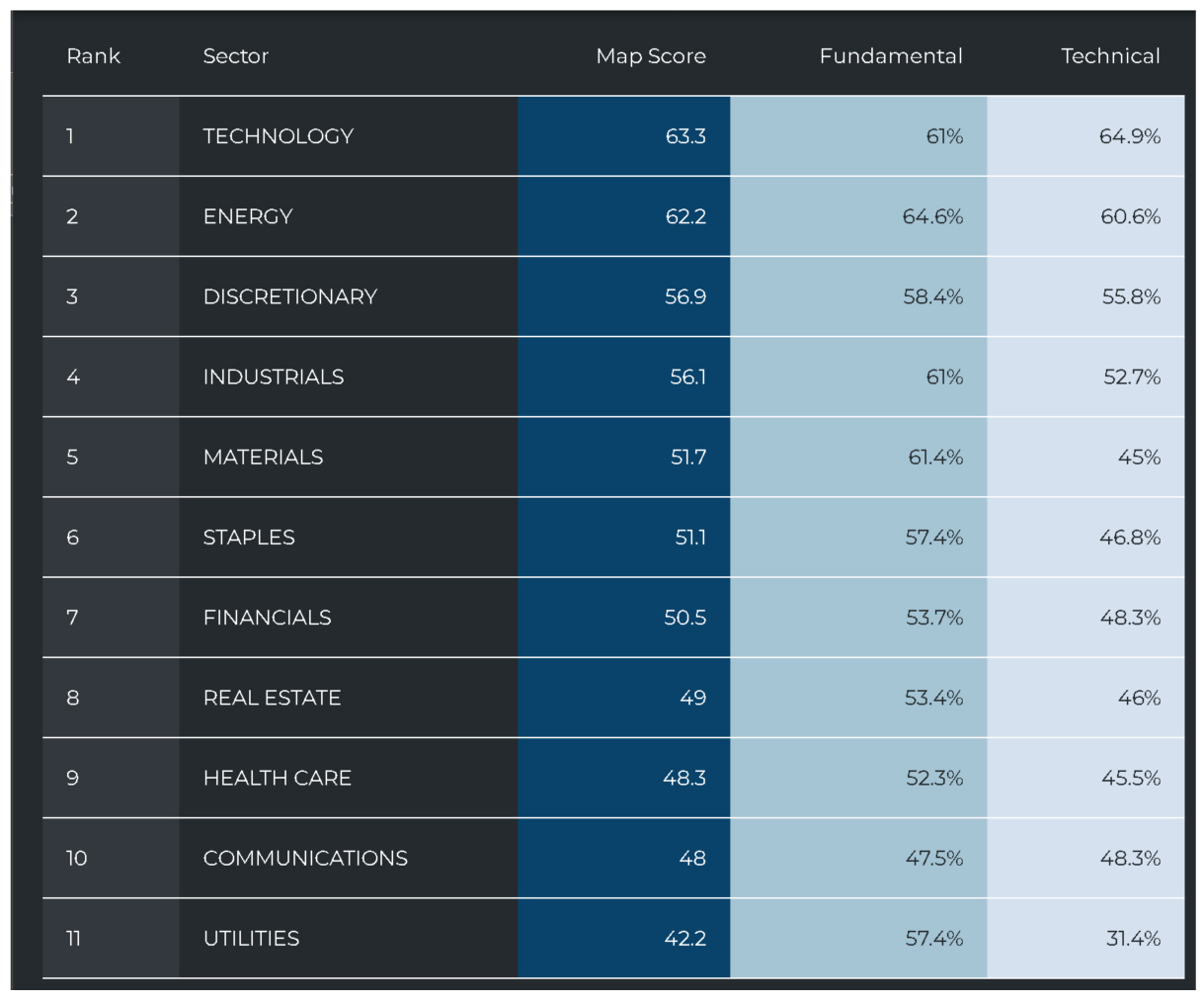
Graphs are for illustrative and discussion purposes only. Please read important disclosures at the end of this commentary.
September finds the weather sweet, as some cool winds begin to blow through town. It’s a wonderful time, leading to the fourth-quarter bonanza, the end of the year, which brings holiday cheer and usually great performance for stock investors. September can be a rough month for investors, but it helps to have some perspective. For now, we must slog through this seasonally choppy time of year and look for great stocks on sale. If those are timed right into a big lift at the end of the year, that can add up to juicy gains.
It always helps to have some perspective. This week, September conjures the solemn memory of 9/11, which we shall never forget. What’s a little stock volatility when you have your health and life?
Alan McKay said it best: “Perspective is worth 80 IQ points.”
Navellier & Associates owns Coke (KO) in some managed accounts but does not own Hormel Foods (HRL). Jason Bodner does not own Coke (KO) or Hormel Foods (HRL) personally.
All content above represents the opinion of Jason Bodner of Navellier & Associates, Inc.
Also In This Issue
A Look Ahead by Louis Navellier
World Trade is Waning as the G20 Meets in India
Income Mail by Bryan Perry
Investors Look for A “September to Remember”
Growth Mail by Gary Alexander
September Speculations in Railroads, Real Estate and Russian Rubles
Global Mail by Ivan Martchev
The Yuan Wild Card Just Got Wilder
Sector Spotlight by Jason Bodner
September 11 Puts Any Market Moves in Perspective
View Full Archive
Read Past Issues Here

Jason Bodner
MARKETMAIL EDITOR FOR SECTOR SPOTLIGHT
Jason Bodner writes Sector Spotlight in the weekly Marketmail publication and has authored several white papers for the company. He is also Co-Founder of Macro Analytics for Professionals which produces proprietary equity accumulation/distribution research for its clients. Previously, Mr. Bodner served as Director of European Equity Derivatives for Cantor Fitzgerald Europe in London, then moved to the role of Head of Equity Derivatives North America for the same company in New York. He also served as S.V.P. Equity Derivatives for Jefferies, LLC. He received a B.S. in business administration in 1996, with honors, from Skidmore College as a member of the Periclean Honors Society. All content of “Sector Spotlight” represents the opinion of Jason Bodner
Important Disclosures:
Jason Bodner is a co-founder and co-owner of Mapsignals. Mr. Bodner is an independent contractor who is occasionally hired by Navellier & Associates to write an article and or provide opinions for possible use in articles that appear in Navellier & Associates weekly Market Mail. Mr. Bodner is not employed or affiliated with Louis Navellier, Navellier & Associates, Inc., or any other Navellier owned entity. The opinions and statements made here are those of Mr. Bodner and not necessarily those of any other persons or entities. This is not an endorsement, or solicitation or testimonial or investment advice regarding the BMI Index or any statements or recommendations or analysis in the article or the BMI Index or Mapsignals or its products or strategies.
Although information in these reports has been obtained from and is based upon sources that Navellier believes to be reliable, Navellier does not guarantee its accuracy and it may be incomplete or condensed. All opinions and estimates constitute Navellier’s judgment as of the date the report was created and are subject to change without notice. These reports are for informational purposes only and are not a solicitation for the purchase or sale of a security. Any decision to purchase securities mentioned in these reports must take into account existing public information on such securities or any registered prospectus.To the extent permitted by law, neither Navellier & Associates, Inc., nor any of its affiliates, agents, or service providers assumes any liability or responsibility nor owes any duty of care for any consequences of any person acting or refraining to act in reliance on the information contained in this communication or for any decision based on it.
Past performance is no indication of future results. Investment in securities involves significant risk and has the potential for partial or complete loss of funds invested. It should not be assumed that any securities recommendations made by Navellier. in the future will be profitable or equal the performance of securities made in this report. Dividend payments are not guaranteed. The amount of a dividend payment, if any, can vary over time and issuers may reduce dividends paid on securities in the event of a recession or adverse event affecting a specific industry or issuer.
None of the stock information, data, and company information presented herein constitutes a recommendation by Navellier or a solicitation to buy or sell any securities. Any specific securities identified and described do not represent all of the securities purchased, sold, or recommended for advisory clients. The holdings identified do not represent all of the securities purchased, sold, or recommended for advisory clients and the reader should not assume that investments in the securities identified and discussed were or will be profitable.
Information presented is general information that does not take into account your individual circumstances, financial situation, or needs, nor does it present a personalized recommendation to you. Individual stocks presented may not be suitable for every investor. Investment in securities involves significant risk and has the potential for partial or complete loss of funds invested. Investment in fixed income securities has the potential for the investment return and principal value of an investment to fluctuate so that an investor’s holdings, when redeemed, may be worth less than their original cost.
One cannot invest directly in an index. Index is unmanaged and index performance does not reflect deduction of fees, expenses, or taxes. Presentation of Index data does not reflect a belief by Navellier that any stock index constitutes an investment alternative to any Navellier equity strategy or is necessarily comparable to such strategies. Among the most important differences between the Indices and Navellier strategies are that the Navellier equity strategies may (1) incur material management fees, (2) concentrate its investments in relatively few stocks, industries, or sectors, (3) have significantly greater trading activity and related costs, and (4) be significantly more or less volatile than the Indices.
ETF Risk: We may invest in exchange traded funds (“ETFs”) and some of our investment strategies are generally fully invested in ETFs. Like traditional mutual funds, ETFs charge asset-based fees, but they generally do not charge initial sales charges or redemption fees and investors typically pay only customary brokerage fees to buy and sell ETF shares. The fees and costs charged by ETFs held in client accounts will not be deducted from the compensation the client pays Navellier. ETF prices can fluctuate up or down, and a client account could lose money investing in an ETF if the prices of the securities owned by the ETF go down. ETFs are subject to additional risks:
- ETF shares may trade above or below their net asset value;
- An active trading market for an ETF’s shares may not develop or be maintained;
- The value of an ETF may be more volatile than the underlying portfolio of securities the ETF is designed to track;
- The cost of owning shares of the ETF may exceed those a client would incur by directly investing in the underlying securities; and
- Trading of an ETF’s shares may be halted if the listing exchange’s officials deem it appropriate, the shares are delisted from the exchange, or the activation of market-wide “circuit breakers” (which are tied to large decreases in stock prices) halts stock trading generally.
Grader Disclosures: Investment in equity strategies involves substantial risk and has the potential for partial or complete loss of funds invested. The sample portfolio and any accompanying charts are for informational purposes only and are not to be construed as a solicitation to buy or sell any financial instrument and should not be relied upon as the sole factor in an investment making decision. As a matter of normal and important disclosures to you, as a potential investor, please consider the following: The performance presented is not based on any actual securities trading, portfolio, or accounts, and the reported performance of the A, B, C, D, and F portfolios (collectively the “model portfolios”) should be considered mere “paper” or pro forma performance results based on Navellier’s research.
Investors evaluating any of Navellier & Associates, Inc.’s, (or its affiliates’) Investment Products must not use any information presented here, including the performance figures of the model portfolios, in their evaluation of any Navellier Investment Products. Navellier Investment Products include the firm’s mutual funds and managed accounts. The model portfolios, charts, and other information presented do not represent actual funded trades and are not actual funded portfolios. There are material differences between Navellier Investment Products’ portfolios and the model portfolios, research, and performance figures presented here. The model portfolios and the research results (1) may contain stocks or ETFs that are illiquid and difficult to trade; (2) may contain stock or ETF holdings materially different from actual funded Navellier Investment Product portfolios; (3) include the reinvestment of all dividends and other earnings, estimated trading costs, commissions, or management fees; and, (4) may not reflect prices obtained in an actual funded Navellier Investment Product portfolio. For these and other reasons, the reported performances of model portfolios do not reflect the performance results of Navellier’s actually funded and traded Investment Products. In most cases, Navellier’s Investment Products have materially lower performance results than the performances of the model portfolios presented.
This report contains statements that are, or may be considered to be, forward-looking statements. All statements that are not historical facts, including statements about our beliefs or expectations, are “forward-looking statements” within the meaning of The U.S. Private Securities Litigation Reform Act of 1995. These statements may be identified by such forward-looking terminology as “expect,” “estimate,” “plan,” “intend,” “believe,” “anticipate,” “may,” “will,” “should,” “could,” “continue,” “project,” or similar statements or variations of such terms. Our forward-looking statements are based on a series of expectations, assumptions, and projections, are not guarantees of future results or performance, and involve substantial risks and uncertainty as described in Form ADV Part 2A of our filing with the Securities and Exchange Commission (SEC), which is available at www.adviserinfo.sec.gov or by requesting a copy by emailing info@navellier.com. All of our forward-looking statements are as of the date of this report only. We can give no assurance that such expectations or forward-looking statements will prove to be correct. Actual results may differ materially. You are urged to carefully consider all such factors.
FEDERAL TAX ADVICE DISCLAIMER: As required by U.S. Treasury Regulations, you are informed that, to the extent this presentation includes any federal tax advice, the presentation is not written by Navellier to be used, and cannot be used, for the purpose of avoiding federal tax penalties. Navellier does not advise on any income tax requirements or issues. Use of any information presented by Navellier is for general information only and does not represent tax advice either express or implied. You are encouraged to seek professional tax advice for income tax questions and assistance.
IMPORTANT NEWSLETTER DISCLOSURE:The hypothetical performance results for investment newsletters that are authored or edited by Louis Navellier, including Louis Navellier’s Growth Investor, Louis Navellier’s Breakthrough Stocks, Louis Navellier’s Accelerated Profits, and Louis Navellier’s Platinum Club, are not based on any actual securities trading, portfolio, or accounts, and the newsletters’ reported hypothetical performances should be considered mere “paper” or proforma hypothetical performance results and are not actual performance of real world trades. Navellier & Associates, Inc. does not have any relation to or affiliation with the owner of these newsletters. There are material differences between Navellier Investment Products’ portfolios and the InvestorPlace Media, LLC newsletter portfolios authored by Louis Navellier. The InvestorPlace Media, LLC newsletters contain hypothetical performance that do not include transaction costs, advisory fees, or other fees a client might incur if actual investments and trades were being made by an investor. As a result, newsletter performance should not be used to evaluate Navellier Investment services which are separate and different from the newsletters. The owner of the newsletters is InvestorPlace Media, LLC and any questions concerning the newsletters, including any newsletter advertising or hypothetical Newsletter performance claims, (which are calculated solely by Investor Place Media and not Navellier) should be referred to InvestorPlace Media, LLC at (800) 718-8289.
Please note that Navellier & Associates and the Navellier Private Client Group are managed completely independent of the newsletters owned and published by InvestorPlace Media, LLC and written and edited by Louis Navellier, and investment performance of the newsletters should in no way be considered indicative of potential future investment performance for any Navellier & Associates separately managed account portfolio. Potential investors should consult with their financial advisor before investing in any Navellier Investment Product.
Navellier claims compliance with Global Investment Performance Standards (GIPS). To receive a complete list and descriptions of Navellier’s composites and/or a presentation that adheres to the GIPS standards, please contact Navellier or click here. It should not be assumed that any securities recommendations made by Navellier & Associates, Inc. in the future will be profitable or equal the performance of securities made in this report.
FactSet Disclosure: Navellier does not independently calculate the statistical information included in the attached report. The calculation and the information are provided by FactSet, a company not related to Navellier. Although information contained in the report has been obtained from FactSet and is based on sources Navellier believes to be reliable, Navellier does not guarantee its accuracy, and it may be incomplete or condensed. The report and the related FactSet sourced information are provided on an “as is” basis. The user assumes the entire risk of any use made of this information. Investors should consider the report as only a single factor in making their investment decision. The report is for informational purposes only and is not intended as an offer or solicitation for the purchase or sale of a security. FactSet sourced information is the exclusive property of FactSet. Without prior written permission of FactSet, this information may not be reproduced, disseminated or used to create any financial products. All indices are unmanaged and performance of the indices include reinvestment of dividends and interest income, unless otherwise noted, are not illustrative of any particular investment and an investment cannot be made in any index. Past performance is no guarantee of future results.
